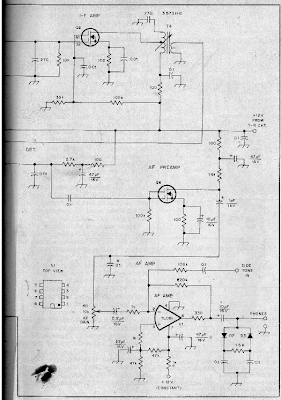From: Rich
To: "soldersmoke@yahoo.com"
Sent: Thursday, January 22, 2015 9:22 AM
Subject: Cheap, open source Arduino SDR project
Sent: Thursday, January 22, 2015 9:22 AM
Subject: Cheap, open source Arduino SDR project
Bill
First, thanks for Soldersmoke and all you do for us QRP hackers around the world. I'm a big fan!
I've detected you are getting sucked into the world of microcontrollers of late. I know you are not really that excited about SDR but this is a radio that combines Arduino, the currently popular SI5351 and a Softrock to make a very functional SDR. I started this project last year which uses the fabulous Teensy 3.1 and companion audio shield. I recently packaged it all up and it looks like a QRP radio now. Still doesn't transmit but as I like to say thats "just a small matter of software".
There are several posts about it on my blog. The most recent:
There's a link to a video and a link to the code in that post.
Rock on Bill!
73, Rich Heslip
VE3MKC
From: solder smoke
Sent: Friday, January 23, 2015 4:09 AM
To:
Subject: Re: Cheap, open source Arduino SDR project
Wow Rich that is really beautiful. Amazing! I am also sending this to Pete Juliano, but I was at first hesitant about this because I feared that your combination of Si5351 and TFT display might be TOO exciting for him. Deep breaths Pete...
73 and Thanks, Bill
From: jessystems@verizon.net
To: soldersmoke@yahoo.com;
Subject: Re: Cheap, open source Arduino SDR project
Date: Fri, 23 Jan 2015 06:03:40 -0800
To: soldersmoke@yahoo.com;
Subject: Re: Cheap, open source Arduino SDR project
Date: Fri, 23 Jan 2015 06:03:40 -0800
Hi Rich & Bill,
Wow –really exciting project Rich! Congratulations and Bravo!
This is so exciting, for all hams, as this just shows the power of the available low cost technology that is now on the market. Your project is really tempting as I have a V6.2 15M softrock sitting in a box (somewhere). I was somewhat put off with the Power SDR as the opposite sideband rejection is not too good –it is clear you have cracked that nut.
Thanks for sharing Rich and yes Bill I am taking very deep breaths.
73’s
Pete N6QW
Thanks guys! When I saw the Teensy 3.1 with the companion audio codec board the first thing that came to mind was a portable SDR. Since its Arduino compatible I am able to leverage the SI5351 library, encoder library etc so its mostly just putting software blocks together. The digital filter design is a bit tricky but Loftur VE2LJX did quite a bit of work on that and now it works really well.
I hope to add CW decoding and PSK31 at some point. I've used less than half the flash on the Teensy so lots of room for new features. I'm hoping if the word gets out I won't have to do this all myself!
Pete - too bad you missed the Black Friday sale - Teensy 3.1 and the audio shield for $18. Deep breaths...
: )
73, Rich
VE3MKC
Our book: "SolderSmoke -- Global Adventures in Wireless Electronics" http://soldersmoke.com/book.htm Our coffee mugs, T-Shirts, bumper stickers: http://www.cafepress.com/SolderSmoke Our Book Store: http://astore.amazon.com/contracross-20














